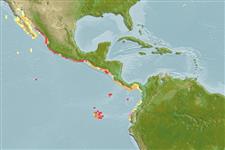Environment: milieu / climate zone / depth range / distribution range
Ökologie
seewasser riff-verbunden; tiefenbereich 1 - 40 m (Ref. 55763). Tropical; 33°N - 2°S, 120°W - 70°W
Eastern Pacific: Gulf of California to Ecuador, including the Galapagos Islands (Ref. 9310); and Peru (first record).
Size / Gewicht / Alter
Maturity: Lm ? range ? - ? cm
Max length : 53.0 cm TL Männchen/unbestimmt; (Ref. 55763); common length : 25.0 cm TL Männchen/unbestimmt; (Ref. 55763)
Body oval, somewhat elongate, and compressed (depth contained less than 2.0 times in standard length); head and mouth small; teeth highly characteristic, forming a single anterior row in each jaw, incisiform and somewhat lanceolate in shape, resembling the head of a golf club, their roots compressed and horizontally set, forming a striated plate inside the mouth; vomer toothed; dorsal fin with 13 soft rays; lateral line scales 59 to 61; first anal ray longer than subsequent rays; body entirely dark gray, with dark stripes on flanks; sometimes with white spots (Ref. 55763).
Sometimes seen in schools of K. analogus, also known to school and graze with Prionurus laticlavius. Stays close to shore in shallow waters. Feeds mainly on attached algae, occasionally ingests plankton and benthic invertebrates (Ref. 28023).
Life cycle and mating behavior
Geschlechtsreife | Fortpflanzung | Ablaichen | Eier | Fecundity | Larven
Knudsen, S.W. and K.D. Clements, 2013. Revision of the fish family Kyphosidae (Teleostei: Perciformes). Zootaxa 3751(1):001-101. (Ref. 95491)
IUCN Rote Liste Status (Ref. 130435: Version 2024-1)
Bedrohung für Menschen
Harmless
Nutzung durch Menschen
Fischereien: weniger kommerziell; Sportfisch: ja
Tools
Zusatzinformationen
Download XML
Internet Quellen
Estimates based on models
Preferred temperature (Ref.
123201): 18.6 - 28.4, mean 21.6 °C (based on 8 cells).
Phylogenetic diversity index (Ref.
82804): PD
50 = 0.5000 [Uniqueness, from 0.5 = low to 2.0 = high].
Bayesian length-weight: a=0.01778 (0.00765 - 0.04135), b=3.01 (2.81 - 3.21), in cm total length, based on LWR estimates for this (Sub)family-body shape (Ref.
93245).
Trophic level (Ref.
69278): 2.9 ±0.32 se; based on food items.
Widerstandsfähigkeit (Ref.
120179): mittel, Verdopplung der Population dauert 1,4 - 4,4 Jahre. (Preliminary K or Fecundity.).
Fishing Vulnerability (Ref.
59153): Moderate vulnerability (41 of 100).
Nutrients (Ref.
124155): Calcium = 38.5 [20.5, 64.7] mg/100g; Iron = 0.522 [0.325, 0.810] mg/100g; Protein = 18.5 [17.3, 19.6] %; Omega3 = 0.0913 [, ] g/100g; Selenium = 36.2 [21.1, 64.8] μg/100g; VitaminA = 43.6 [12.1, 144.5] μg/100g; Zinc = 1.09 [0.77, 1.52] mg/100g (wet weight);
